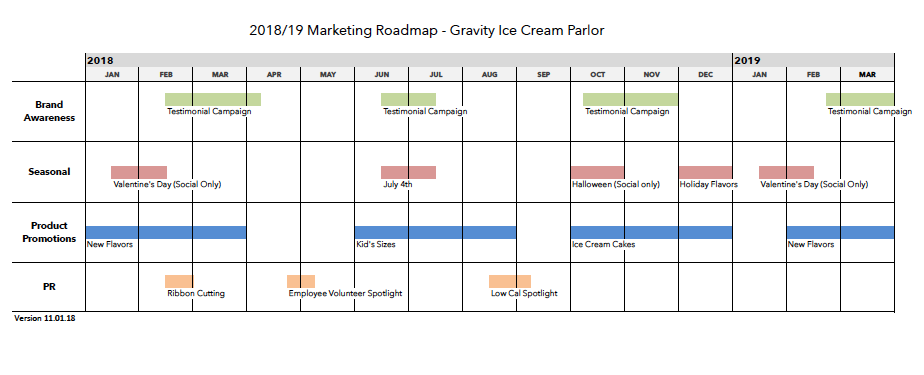Table of Contents
A roadmap is an important tool that keeps all marketing efforts on track–it creates a shared understanding of what is to be done and when, helps with marketing resource allocation, facilitates project management, and gives managers a way to ensure that marketing efforts are on time and on budget. It’s the action-oriented guide to to any effective marketing strategy. Not to mention, without a roadmap showing all your marketing efforts and when they are launching, it’s difficult to put together a coherent marketing budget.
Whether you’re putting together your first roadmap, or looking for ways to improve on one you already have, here are some tips on taking your game to the next level.
How do a roadmap and a budget work together?
In marketing execution, being on budget means delivering on time, as delays often cost both time and money. For instance, media placement is generally negotiated while the creative for a campaign is being developed. If the creative is delayed, media has to be renegotiated, and placement opportunities are often lost.
Additionally, marketing efforts are often tied to triggers, product offers, and specific monetary goals. If the marketing isn’t executed on time and in the right sequence, it isn’t likely it will succeed, decreasing your marketing budget’s ROI.
What is included in a roadmap?
We’ve found that roadmaps can be most effective when you keep them relatively simple. Your roadmap should be a visual representation of campaigns and messaging by month, similar to a Gantt chart. It can be separated into sections by sub-brand, product line, etc., or even by audience, e.g. to distinguish between messages that will be to current customers vs. the public.
Additional details, such as creative direction, offers, and placement details are best outlined in a Project Brief or an ancillary document and not on the roadmap itself. Including too much on the roadmap detracts from the visual nature of the document, making it difficult to see how campaigns overlap at a glance while also making it more difficult to keep it up to date.
Does having a roadmap mean I can’t take advantage of new opportunities throughout the year?
Absolutely not! Having a roadmap can actually make it easier to determine if you should take advantage of new opportunities throughout the year by providing a clear picture of other messages in market. A roadmap is a living document that will be regularly updated–new opportunities may be added, campaigns may shift, etc. Most marketing teams do encounter opportunities throughout the year. Just make sure to allocate a budget for opportunities that may arise, but that aren’t on your initial roadmap.
What happens if goals change? What does that mean for my roadmap?
Sometimes goals will change throughout the year, and that’s okay. Because your roadmap is a living document, it’s okay to update it throughout the year as your goals evolve. We’ve found it best to include the date the roadmap was updated in the filename, as well as an “Updated on” date on the roadmap itself so that the version is clear, even when printed. It’s also best to save a PDF version of the roadmap on a central drive where stakeholders can access the current version. We recommend not saving an editable version in a central location as it could easily, and accidentally, be changed or overwritten.
How do I get my Director / VP / CEO on board?
We’ve found that leaders at the C-suite level are very enthusiastic about clear roadmap documents and the discipline that comes with executing them. Successful execution of a marketing strategy is both an art and discipline, and a well thought out roadmap puts all stakeholders on the same page.
How do I get started?
A great place to start is to outline your goals for the year–sales goals, number of new customers, increased awareness, etc–then brainstorm the types of opportunities available (traditional media, digital, special events, etc.). Next, create a list of criteria by which to judge each opportunity (things like budget, capacity to create and manage, seasonality, etc.). From there you can start to build your roadmap. It can be helpful to work through this exercise with a partner like Gravity because not only can we help to guide the process, we also have experience with tools and opportunities you may not have tried before and may not think to include on your roadmap.
It’s also worth mentioning that having a clear brand strategy in place will make this process much more straightforward, in terms of helping you prioritize what messages and products or services to promote.
I have a roadmap…now, how do I make sure it gets executed?
Congratulations! That’s one of the first steps to kicking off the year organized and with an actionable plan. Now that you have your roadmap, and hopefully your corresponding budget, you can translate it into action items by working on Project / Campaign briefs. That’s where the rubber will really meet the road as you outline creative direction, offer, message details, messaging components (video, print, digital, etc.), timelines, and more. Your roadmap will be your guide for the year, and your campaign briefs will be what you work from to design and develop your marketing collateral for each campaign.

